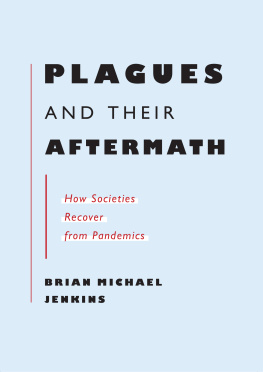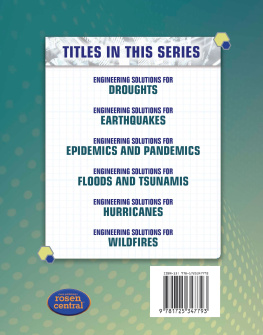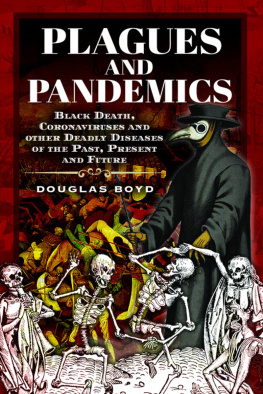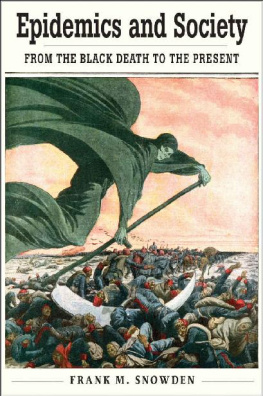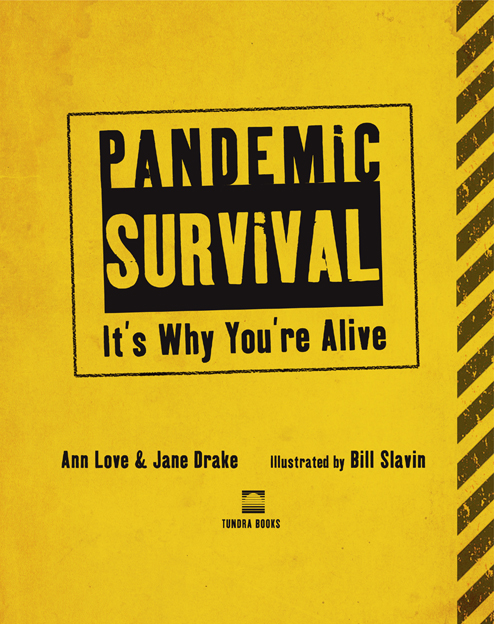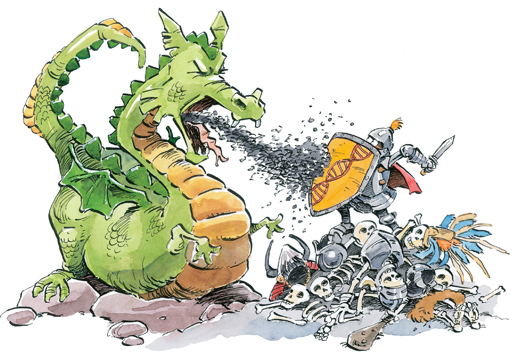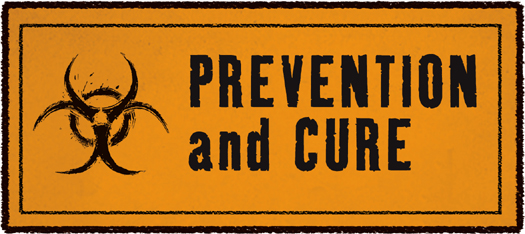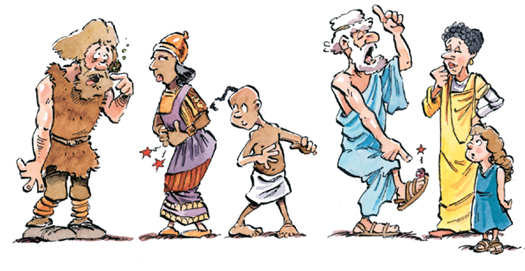Text copyright 2013 by Ann Love and Jane Drake
Illustrations copyright 2013 Bill Slavin
Published in Canada by Tundra Books, a division of Random House of Canada Limited,
One Toronto Street, Suite 300, Toronto, Ontario M5C 2V6
Published in the United States by Tundra Books of Northern New York,
P.O. Box 1030, Plattsburgh, New York 12901
Library of Congress Control Number: 2012951554
All rights reserved. The use of any part of this publication reproduced, transmitted in any form or by any means, electronic, mechanical, photocopying, recording, or otherwise, or stored in a retrieval system, without the prior written consent of the publisheror, in case of photocopying or other reprographic copying, a licence from the Canadian Copyright Licensing Agencyis an infringement of the copyright law.
Library and Archives Canada Cataloguing in Publication
Love, Ann
Pandemic survival : its why youre alive / by Ann Love and Jane Drake; illustrated by Bill Slavin.
eISBN: 978-1-77049-499-2
1. EpidemicsJuvenile literature. 2. Communicable diseasesJuvenile literature. I. Love, Ann II. Slavin, Bill III. Title.
RA653.5.L69 2013 j614.4 C2012-907061-0
We acknowledge the financial support of the Government of Canada through the Canada Book Fund and that of the Government of Ontario through the Ontario Media Development Corporations Ontario Book Initiative. We further acknowledge the support of the Canada Council for the Arts and the Ontario Arts Council for our publishing program.
Edited by Sue Tate and Samantha Swenson
Designed by Leah Springate
The artwork in this book was rendered in pen and ink and watercolor.
www.tundrabooks.com
v3.1
THE MIDDLE AGES
(6001500): SIN and SUFFERING
THE AGE OF DISCOVERY
(15001800): SICKNESS SHIP to SHORE
THE INDUSTRIAL AGE
(18001900): PROSPERITY, POLLUTION, and PANDEMICS
ANTIBIOTICS
BEFORE and AFTER
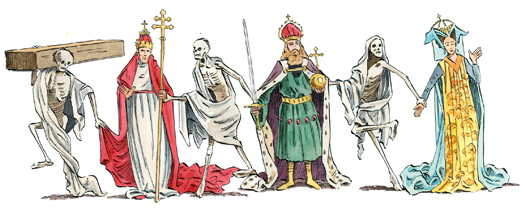
To our family and friends who make the world a healthier placedoctors, nurses, writers, social workers, biologists, environmentalists, artists, lobbyists, caregivers, coaches, advocates, and more
A.L. and J.D.
To Geoff, who has always had a fascination with germs
B.S.
Acknowledgments
Biz Agnew; Henry Barnett; Will Barnett; Alyson Barnett-Cowan; Kim Beatty; Sharon Bentley; Kai Byrom; Brian, Jim, Madeline, and Stephanie Drake; Domenico Inzitari; Donatella Lippi; Adrian, David, Jennifer, and Melanie Love; David and Elizabeth Morley; Helen and Tom Morley; Marie Muir; Oxford Country Public Health and Emergency Services; Roisin Osborne; Evan, Luke, and Olivia Racine; Paul Randall; Mark, Mason, and Sadie Salmoni; Emily Thring; Neil Watters.
Many thanks to the Tundra teamespecially Sue Tate, Samantha Swenson, and Sylvia Chan. What a pleasure to work with Bill Slavin againhe puts a whole new spin on going viral.

Living Proof
An unknown virus that swept through the South Pacific last week, leaving thousands dead, has now spread into China and North America. Today, the Ministry of Health in Beijing reported 248 suspected cases and 17 deaths, while the Center for Disease Control and Prevention in Atlanta, Georgia, reported 13 cases in Seattle.
As a preventative measure, public health officials advise children between the ages of eight and fourteen to bathe in hot goats urine, whip their backs with knotted ropes until they bleed, or kiss a mouse four times daily. If a child develops stinging, red eyes and a barking cough, parents should immediately apply burning metal pokers to the skin in front of the childs ears or wrap the child in a bundle of wet leaves before laying in an open fire. Authorities recommend all house cats be destroyed.
Does that sound crazy? Maybe
The average healthy kid today will catch many colds, flus, and other contagious diseasesand get better againbefore leaving school. But a hundred years ago, a childs chances werent so good. In distant times, terrible plagues, epidemics, and pandemics spread around the world and wiped out entire families and even whole communities. At some point, most kids in the past must have sneezed, coughed, felt dizzy, bent over with a cramp, spiked a fever, or woke up with red spots on their skinand feared for their future. Survivors watched helplessly as beloved parents, sisters, brothers, and friends died in the grips of a scary epidemic.
Depending on where and when they lived, people tried amazing treatmentsmany based on superstitionto prevent and cure infectious diseases, including all the recommendations suggested by the officials in the scenario above. Because of the persistent, even desperate efforts and hopes of ordinary people, we now know which cures work.
Although the treatments often didnt help and many died, the ancestors of kids todayreaching back thousands of yearsrecovered. Everyone alive now is a descendant of survivors.
This book tells stories from the greatest plagues, poxes, and pestilences in historyand about how people learned to overcome them. Whether the stories happened last year or hundreds of years ago, you are connected to each one in a direct way. Survival is in your blood.
Talk about Sick!
Your throat feels raw when you swallow and your head aches. Even the backs of your eyeballs are sore. Chills run up your back andoh!you feel weak at the knees. Youre getting sick, but how sick? Are you still well enough to do homework or walk the dog?
Its not likely an allergy, not with a sore throat. Youve caught somethingthe flu, perhaps. Youre probably infectious. To avoid passing it on, you better sneeze into your sleeve.
Maybe youre not sick enough to go to the doctor. At this point, shed probably tell you its a virus and advise you to drink lots of fluids, take it easy, and come back if you feel much worse.
Once, you remember, it did get worse. You had a raw throat, high fever, and pounding headache. The doctor took a swab and, a few days later, wrote you a prescription for antibiotics because you tested positive for streptococcus, a bacterium (not a virus). Another time, you had a fever and stomach troubles and she did tests looking for some gross parasite like an amoeba or protozoan. Fortunately, that turned out to be negative




